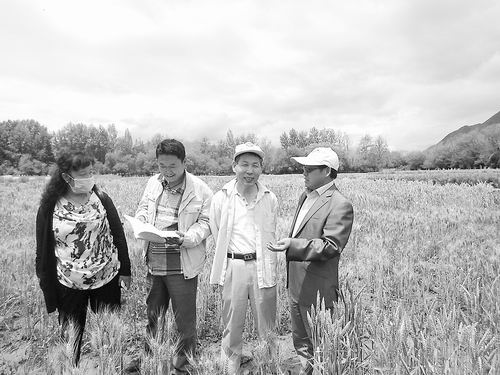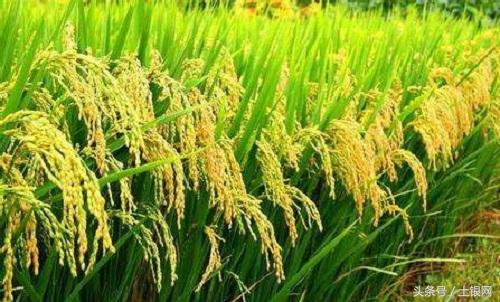The First Successful Introduction of Colored Winter Wheat on Qinghai-Tibet Plateau
August 18, 2014 Source: China Science Daily
This year, with the cooperation of the Institute of Genetics and Development of the Chinese Academy of Sciences and the researchers of Xizang Agricultural Research Institute, 167 colored winter wheat varieties survived the winter safely and were successfully introduced to Lhasa at an altitude of 3600 meters above sea level on the Qinghai-Tibet Plateau for the first time.
Yang Qi, a reporter from the ■ newspaper

The Institute of Genetics and Development and the researchers of Xizang Agricultural Research Institute are in the experimental field of colored winter wheat.
In early August, heavy ears of wheat were produced in 167colored winter wheat on land in Lhasa at an altitude of 3600 meters. This is the first time that colored winter wheat has been successfully introduced on the Qinghai-Tibet Plateau.
"some of the introduced materials have good freeze resistance, drought resistance and agronomic characters, and we can harvest colored wheat of different colors, such as purple, blue, red, white, and so on." Zhang Zhengbin, a researcher at the Agricultural Resource Center of the Institute of Genetics and Developmental Biology of the Chinese Academy of Sciences (hereinafter referred to as the Institute of genetic Development), told China Science Daily.
Highland barley has good frost resistance and can widely adapt to the Qinghai-Tibet Plateau. It is the first major food crop of Xizang. However, due to the poor processing properties of highland barley food, can not be processed into noodles, dumplings, steamed bread and other favorite foods in the north, Xizang also planted a lot of wheat to meet the needs of pasta processing. Wheat has become Xizang's second largest food crop.
"although the development prospect of colored wheat in Xizang needs to be determined by the final test results, this research result is groundbreaking and of far-reaching significance." Xizang Autonomous Academy of Agriculture and Animal Husbandry Academy of Agricultural Research Institute (hereinafter referred to as Xizang Agricultural Research Institute) deputy director Qiang Xiaolin said.
Climate warming brings "rising" space
Wheat is Xizang's second largest food crop. However, due to the limitations of the alpine ecological environment, the planting area of Xizang winter wheat has hovered around 600000 mu in recent years. At the same time, Xizang winter wheat has poor quality and low protein content. Xizang needs to transport a large amount of high-quality wheat from the mainland every year.
How to make wheat "climb" the Qinghai-Tibet Plateau, where it can take root, grow and produce ears of wheat, has always been a difficult problem that scientists hope to overcome.
"in Xizang, there is still a large demand for forage grass in rural areas. we heard that teacher Zhang Zhengbin had some colored wheat and tall stalk materials, and he thought it might be more useful in Xizang, so the cooperation began." Dong Mei, a researcher at Xizang Agricultural Research Institute, told reporters.
Data show that the temperature of Xizang has generally risen in recent years, and the Lhasa area has set a high temperature record of 30 degrees Celsius in the past two years, so the elevation of crop planting is also increasing.
"before, we selected the spring wheat variety 'Zangchun 951', which has a long growth period and is difficult to mature in alpine and semi-arid areas. However, with the climate warming, this variety has been planted and matured in some high-altitude areas such as Lazi in Xigaze. " Wei Yingchun, associate researcher of Xizang Agricultural Research Institute, told reporters.
With the warming of the climate, it is possible to increase the altitude of planting winter wheat, and the area has a tendency to expand, but what bothers researchers is the frost resistance of winter wheat. Dead seedlings or spring freezing are easy to occur in Xizang alpine areas, especially in the period of wheat turning green and jointing, which may lead to a large-scale reduction in winter wheat production.
Therefore, first of all, it is necessary to speed up the breeding of winter wheat varieties which can withstand not only extreme low temperature in winter but also low temperature in spring at jointing stage.
"Climate warming provides an opportunity to expand the cultivation of wheat. This enabled us to introduce 167colored winter wheat resources from Shijiazhuang last year to the alpine areas with an altitude of 3600 meters above sea level. " Zhang Zhengbin said.
"blueberry" in wheat has great potential.
"We used French rye and wild wheat to cross with wheat varieties related to Thinopyrum. The selected colored wheat has good drought resistance, freezing resistance and stress resistance. at the same time, it is rich in micronutrients such as anthocyanins, vitamins, trace elements and high protein, which can enhance the physique of people in cold and anoxic areas." Zhang Zhengbin told reporters.
This kind of colored wheat is rich in anthocyanins, vitamins and trace elements, and is rich in nutrition, especially anthocyanin has good antioxidant and anticancer effects. It can be used as a functional food and is known as the "blueberry" of wheat crops.
This is also one of Zhang Zhengbin's dreams.
If you want to make a breakthrough, you have to work hard.
"basically, the 167materials we introduced this year have survived the winter safely, and many materials have performed well in agronomic characters. On the one hand, they can expand reproduction and carry out demonstration and popularization in the future, on the other hand, they can also be used as high-quality wheat germplasm resources to cross with Xizang winter wheat varieties to speed up the quality improvement of Xizang winter wheat." Wei Yingchun said.
However, it will take several years of hard work to achieve a major breakthrough. They know very well that wheat breeding is a long-term and arduous work. "it takes three days to burn the jade, and it takes seven years to identify the wood." Zhang Zhengbin said so.
During the several months of introducing colored winter wheat on the Qinghai-Tibet Plateau, researchers from the Institute of Genetics and Development and Xizang Agricultural Research Institute encountered many problems.
For example, the difficulties in funding for scientific research. The development of Xizang winter wheat breeding and production is slow, in the wandering stage, the scientific research and breeding strength is weak, the fund investment is small. Zhang Zhengbin said that at present, due to the shortage of funds, they have provided free support to Xizang Agricultural Research Institute to provide germplasm resources such as colored wheat. Because it is to carry out long-distance cooperation and exchanges with poor areas, it also requires a lot of investment in scientific research.
"in particular, we hope to provide Xizang's comrades engaged in winter wheat breeding with more opportunities to study in the mainland and learn new technologies such as molecular genetics, so as to speed up the further development of Xizang's winter wheat genetics and breeding. at the same time, a large amount of scientific research funds are needed to improve Xizang's local scientific research ability and the construction of the scientific research platform." Zhang Zhengbin said.
China Science Daily (progress on page 6, 2014-08-18)
Related
- A course of planting techniques and methods on how to grow carrots
- How to plant the latest tulips?
- Is it better to pick tea in the morning or in the afternoon? When is the best time for tea to be picked? what is the third or fifth tea?
- Launch Yuanxiao Happy combination Haocha + Tea Yuan healthy Taste
- Penghu Tourism "Fireworks 20 Parade with You"
- 2022 West Lake Happiness holds "Digital Revitalization Voucher" and draws iphone13 and laptop.
- Banqiao Fuzhou social houses are designed to change start-up combined with police elimination to create a safe and livable environment
- The convenient measure of "mechanical weeding" in Xinbei has been abused and the Agriculture Bureau has imposed heavy penalties on the illegal land consolidation.
- Changgeng University Joins Hands with Four Memory Factories to Rescue Memory Talent Shortage
- The list of Taiwan's top 100 MVP managers is listed by the Director-General of the Farmers' Association of Sanxia District.



